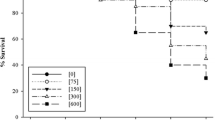Abstract
Laboratory trials were undertaken to investigate the transmission of 2 bacterial pathogens (Serratia marcescens Bizio andBacillus thuringiensis Berliner) by the ovipositor of a braconid parasitoid,Bracon brevicornis Wesmael into the body cavity ofSesamia cretica Lederer.
The braconid's ovipositor was able to transmit the 2 bacterial pathogens and plays as inoculating needle. The host larvaeS. cretica were significantly immobilized faster by the contaminated ovipositor of a parasitoid (in case of the 2 pathogens).
After successful transmission of the bacterial pathogen into the body cavity of host larvae, different deleterious effects were significantly found for the parasitoid and its progeny specially in case ofS. marcescens.
Through contamination of the ovipositor, the non-sporeforming bacterium,S. marcescens has more pathogenic effects on the parasitoid and its progeny than the sporeforming bacterium,B. thuringiensis.
Zusammenfassung
Laborversuche mit den beiden BakterienSerratia marcescens undBacillus thuringiensis, mit denen die Legebohrer vonBracon brevicornis, als Parasitoid auf den Raupen vonSesamia cretica, kontaminiert wurden, ergaben, daß der Legebohrer als Injektionsnadel zur Einbringung der beiden Pathogene in den Wirtskörper fungiert. Die Wirtsraupen wurden durch kontaminierte Anstiche signifikant stärker immobilisiert als durch nicht-kontaminierte.
Nach erfolgter Übertragung der Pathogene in den Wirtskörper traten verschiedene nachteilige Wirkungen für den Parasitoiden auf, die beiS. marcesscens wesentlich stärker waren als beiB. thuringiensis. Letzteres Bakterium ist daher zur biologischen Bekämpfung besser geeignet als das erstere.
Similar content being viewed by others
Literaturverzeichnis
Bell, J. V., King, E. G., Hamalle, R. J., 1974: Interactions between bollworms, a braconid parasite, and the bacteriumSerratia marcescens. Ann. Entomol. Soc. Am.6,7, 712–714.
Brachen, G. K., Bucher, G. E., 1967: Mortality of Hymenopterous parasite caused bySerratia marcescens. J. Invertebr. Pathol.9, 130–132.
Bucher, G. E., 1963: Transmission of bacterial pathogens by the ovipositor of a hymenopterous parasite. J. Insect. Pathol.5, 277–283.
Hall, I. M., 1963: Microbial control. pp. 477–517 in “Insect Pathology” (E. A. Steinhaus, ed.) Vol. 2 Academic Press, N. Y. and London.
King, E. G., Bell, J. V., Martin, D. E., 1975: Control of the bacteriumSerratia marcescens in an insect hostparasite rearing program. J. Invertebr. Pathol.26, 35–40.
Kurstak, E. S., 1966: The role ofDevorgilla canescens (Grav.), in infection byBacillus thuringiensis Berliner, inEphestia Küehniella Zell. Annals Epiphyt.17 (3), 335–383 (cf. RAE/56 A, 445, 1968.
Laigo, F. M., Tamashiro, M., 1967: Interactions between a microsporidian pathogen of the lawn-army worm and the hymenopterous parasiteApanteles marginiventris. J. Invertebr. Pathol.9, 546–554.
Oatman, E. R., 1965: The effect ofBacillus thuringiensis Berliner on some lepidopterous larval pasts, apple aphid and predators, and on phytophagous and predaceous mites on young apple trees. J. Econ. Entomol.58, 1144 to 1147.
Raimo, B., Reardon, R. C., Podgwaite, J. D., 1977: Vectoring gypsy moth nuclear polyhedrosis virus byApanteles melanoscelus (Hym: Braconidae). Entomophaga22, 207–215.
Reardon, R. C., Podgwalte, J. D., 1976: Disease-parasitoid relationships in natural populations ofLymantria dispar (Lep.: Lymantriidae) in the Northeastern United States. Entomophaga21, 333–341.
Steinhaus, E. A., 1949: Principles of insect pathology. McGraw Hill Book Co. Inc. N. Y. 757 p.
Steinhaus, E. A., 1959:Serratia marcescens Bizio as an insect pathogen. Hilgardia28, 351–380.
Temerak, S. A., 1971: Microbial control of phytophagous insects in Upper Egypt. M. Sc. Thesis Coll. of Agr. Assiut Univ., Egypt.
Temerak, S. A., 1978: Infectivity tests utilizing the redpigmented bacteriamSerratia marcescens (Bizio) against the grasshopper,Aiolopus strepens (Latr.). Proc. 4th. Conf. Pest Control NRC, Cairo p. 700–707.
Temerak, S. A., 1979a: Interactions between the red-pigmented bacterium,Serratia marcescens, the pink borer,Sesamia cretica, and the parasitoid,Bracon brevicornis. Proc. 3rd. Pesticide Conf. Tanta Univ., Egypt Vol. IB p. 519–526.
Temerak, S. A., 1979b: Laboratory trials to investigate disease-parasitoid relationships in natural population of the pink borer,Sesamia cretica Lederer in storage area of corn stalks. Proc. 3rd. Pesticide Conf. Tanta Univ., Egypt Vol. IB p. 527–533.
Temerak, S. A., 1980: Detrimental effects of rearing a braconid parasitoid on the pink borer larvae inoculated by different concentrations of the bacterium,Bacillus thuringiensis, Berliner. Z. ang. Ent.89, 315–319.
Wollam, J. D., Yendol, J. D., 1976: Evaluation ofBacillus thuringiensis and a parasitoid for suppression of the gypsy moth. J. Econ. Entomol.69, 113–118.
Author information
Authors and Affiliations
Additional information
Mit 3 Tabellen
Rights and permissions
About this article
Cite this article
Temerak, S.A. Übertragung zweler bakterieller Pathogene in den Körper von Sesamia cretica Led. (Lep., Tortricidae) mittels des Legebohrers von Bracon brevicornis Wesm. (Hym., Braconidae). Anz. Schadlingskde., Pflanzenschutz, Umweltschutz 55, 89–92 (1982). https://doi.org/10.1007/BF01907607
Issue Date:
DOI: https://doi.org/10.1007/BF01907607




